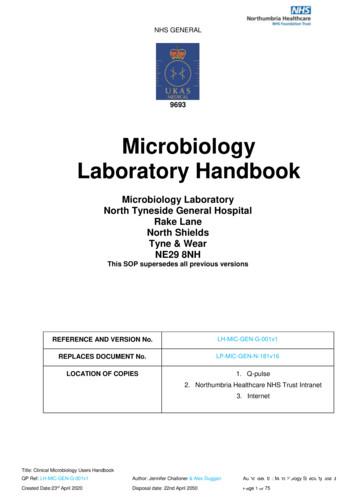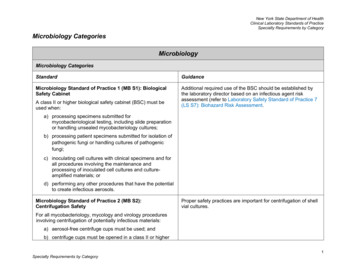Industrial Microbiology: An Introduction
Industrial Microbiology:An IntroductionMichael J. WaitesBSc, PhD, CBiol, MIBiolNeil L. MorganBSc, PhD, MIFSTJohn S. RockeyBSc, MSc, PhDGary HigtonBSc, PhDAll:School of Applied Science, South Bank University,London, UK
Industrial Microbiology: An Introduction
Industrial Microbiology:An IntroductionMichael J. WaitesBSc, PhD, CBiol, MIBiolNeil L. MorganBSc, PhD, MIFSTJohn S. RockeyBSc, MSc, PhDGary HigtonBSc, PhDAll:School of Applied Science, South Bank University,London, UK
2001 byBlackwell Science LtdEditorial Offices:Osney Mead, Oxford OX2 0EL25 John Street, London WC1N 2BS23 Ainslie Place, Edinburgh EH3 6AJ350 Main Street, MaldenMA 02148-5018, USA54 University Street, CarltonVictoria 3053, Australia10, rue Casimir Delavigne75006 Paris, FranceOther Editorial Offices:Blackwell Wissenschafts-Verlag GmbHKurfürstendamm 5710707 Berlin, GermanyBlackwell Science KKMG Kodenmacho Building7–10 Kodenmacho NihombashiChuo-ku, Tokyo 104, JapanIowa State University PressA Blackwell Science Company2121 S. State AvenueAmes, Iowa 50014-8300, USAThe right of the Authors to beidentified as the Authors of this Workhas been asserted in accordancewith the Copyright, Designs andPatents Act 1988.All rights reserved. No part ofthis publication may be reproduced,stored in a retrieval system, ortransmitted, in any form or by anymeans, electronic, mechanical,photocopying, recording or otherwise,except as permitted by the UKCopyright, Designs and Patents Act1988, without the prior permissionof the copyright owner.First published 2001Set by Best-set Typesetter Ltd., Hong KongPrinted and bound in Great Britain byT.J. International Ltd, Padstow, Cornwall.distributorsMarston Book Services LtdPO Box 269Abingdon, Oxon OX14 4YN(Orders: Tel: 01235 465500Fax: 01235 465555)USABlackwell Science, Inc.Commerce Place350 Main StreetMalden, MA 02148-5018(Orders: Tel: 800 759 6102781 388 8250Fax: 781 388 8255)CanadaLogin Brothers Book Company324 Saulteaux CrescentWinnipeg, Manitoba R3J 3T2(Orders: Tel: 204 837 2987)AustraliaBlackwell Science Pty Ltd54 University StreetCarlton, Victoria 3053(Orders: Tel: 3 9347 0300Fax: 3 9347 5001)A catalogue record for this titleis available from the British LibraryISBN 0-632-05307-0Library of CongressCataloging-in-Publication DataIntroduction to Industrial Microbiology/Michael J. Waites . . . [et al.].p.cm.ISBN 0-632-05307-0 (pbk.)1. Industrial Microbiology: an Introduction.I. Waites, Michael J.QR53 .I522 2001660.6 2—dc212001025874For further information onBlackwell Science, visit our website:www.blackwell-science.comThe Blackwell Science logo is atrade mark of Blackwell Science Ltd,registered at the United KingdomTrade Marks Registry
DedicationThis book is dedicated to the memory of our great friend and co-author Gary Higtonwho, at the age of only 40 years, died unexpectedly during the final stages of its preparation. Gary was a knowledgeable microbiologist, a fine teacher, supportive colleague anda loyal friend. He is greatly missed by us all.
ContentsPreface, ixAcknowledgements, xiIntroduction to industrial microbiology, 1Part 1 Microbial physiology123Microbial cell structure and function, 7Microbial growth and nutrition, 21Microbial metabolism, 46Part 2 Bioprocessing45678Industrial microorganisms, 75Fermentation media, 86Fermentation systems, 94Downstream processing, 109Product development, regulation and safety, 124Part 3 Industrial processes and products91011121314151617Microbial enzymes, 133Fuels and industrial chemicals, 144Health care products, 165Food and beverage fermentations, 179Food additives and supplements, 210Microbial biomass production, 218Environmental biotechnology, 229Microbial biodeterioration of materials and its control, 247Animal and plant cell culture, 258Index, 265vii
PrefaceIndustrial microbiology is primarily associated withthe commercial exploitation of microorganisms, andinvolves processes and products that are of majoreconomic, environmental and social importancethroughout the world. There are two key aspects of industrial microbiology, the first relating to production ofvaluable microbial products via fermentation processes.These include traditional fermented foods and beverages, such as bread, beer, cheese and wine, which havebeen produced for thousands of years. In addition, overthe last hundred years or so, microorganisms have beenfurther employed in the production of numerous chemical feedstocks, energy sources, enzymes, food ingredients and pharmaceuticals. The second aspect is the roleof microorganisms in providing services, particularlyfor waste treatment and pollution control, which utilizes their abilities to degrade virtually all natural andman-made products. However, such activities must becontrolled while these materials are in use, otherwiseconsequent biodeterioration leads to major economiclosses.This textbook is intended to be an introduction to industrial microbiology. In writing it, the authors havedrawn on their experience teaching industrial microbiology and other aspects of applied microbiologyto undergraduates and masters students on a range ofapplied biology, microbiology, biotechnology, food science and chemical engineering courses. It is assumedthat the reader will have an elementary knowledge ofmicrobiology and biochemistry. Nevertheless, eventhose students with only a basic knowledge of chemistryand cell biology, and those who are not specialist microbiologists, should find the material accessible.The book is divided into three sections. Part 1 isdesigned to underpin the main content. Its aim is toprovide a sufficient, albeit brief, overview of microbialstructure, physiology and biochemistry to enable thestudent to fully appreciate the diversity of microorganisms and their metabolic capabilities. The reader shouldsoon come to recognize the versatility of microorgan-isms, their ability to grow on a wide range of substratesand to produce an extensive array of products, many ofwhich are commercially available.Part 2 is devoted to bioprocessing. It examines thecommercial fermentation operations and requirementsfor large-scale cultivation of microorganisms. Thisinvolves the acquisition and development of suitableproduction strains that must then be provided withnutrients, especially appropriate carbon and energysources. The object of any industrial fermentation isthen to optimize either growth of the organism orthe production of a target microbial product. This isnormally achieved by performing fermentations underrigorously controlled conditions in large fermenterswith culture capacities often in excess of severalthousand litres. The design and operation of thesefermentation processes is discussed, along with thedownstream processing operations necessary for the recovery and purification of the target products. Aspectsof safety and good manufacturing practices are alsoexamined.Over the last twenty years, many traditional and established industrial fermentation processes have beenadvanced through the contribution of genetic engineering (in vitro recombinant DNA technology). This technology has also facilitated the development of manynovel processes and products. It not only acceleratesstrain development, leading to improvements in theproduction microorganisms, but can aid downstreamprocessing and other elements of the process. Initially, itinvolved the manipulation of bacteria, but has movedto cloning in yeasts, filamentous fungi, and plant andanimal cells. Developments in this field continue togrow rapidly.There are several good texts that cover the fundamental aspects of genetic manipulation of microorganisms.Consequently, we have not attempted to give a detailedaccount of such techniques here, they are merely introduced and further reading is suggested. Nevertheless,many examples of the application and potential ofix
xPrefacegenetically engineered microorganisms within industrial processes are discussed.Part 3 explores the wide range of industrial microbialprocesses and products, including human food andanimal feed production, the provision of chemicalfeedstocks, alternative energy sources, enzymes andproducts for application in human and animal health.We consider that the economic and scientific importance of traditional and long-established fermentationprocesses can be somewhat overlooked, as attention isoften dominated by more recent developments. Therefore we have aimed to give a balanced and comprehensive coverage of current industrial processes and theirproducts. The production of valuable commoditiesfrom animal and plant cell culture is also included,primarily because the culture and handling of suchcells involves techniques similar to those used for thepropagation of microorganisms.An additional aspect of industrial microbiology, examined here, is the application of extensive degradativeabilities of microorganisms, particularly the harnessingof these properties in waste treatment and pollutioncontrol. The necessity to limit these activities in inappropriate situations, i.e. the prevention of biodeterioration of materials while still in use, is also discussed.
AcknowledgementsWe would like to thank the following authors and the publishers for allowing us to use figuresand tables from their publications:Figs 1.1 and 3.12 are from Dawes, I. W. & Sutherland, I. W. (1992) Microbial Physiology,2nd Edition. Blackwell Scientific Publications.Fig. 1.2 is from Poxton, I. R. (1993) Journal of Applied Bacteriology Supplement 74, 1S–11S.Figs 4.3, 7.8 and 7.9 are from Brown, C. M., Campbell, I. & Priest, F. G. (1987) Introductionto Biotechnology. Blackwell Scientific Publications.Fig. 12.7 is from Lewis, M. & Young, T. W. (1995) Brewing. Chapman & Hall.Tables 12.3 and 12.4 are based on tables in Bamforth, C. W. (1985) The use of enzymes inbrewing. Brewers’ Guardian 114, 21–26.In addition, we wish to thank our colleague Dr Tom Coultate for his advice and enthusiasticsupport.xi
Introduction to industrial microbiologyTraditional fermentation processes, such as thoseinvolved in the production of fermented dairy productsand alcoholic beverages, have been performed forthousands of years. However, it is less than 150 yearsago that the scientific basis of these processes was firstexamined. The birth of industrial microbiology largelybegan with the studies of Pasteur. In 1857 he finallydemonstrated beyond doubt that alcoholic fermentation in beer and wine production was the result ofmicrobial activity, rather than being a chemical process.Prior to this, Cagniard-Latour, Schwann and severalother notable scientists had connected yeast activitieswith fermentation processes, but they had largely beenignored. Pasteur also noted that certain organisms couldspoil beer and wine, and that some fermentations wereaerobic, whereas others were anaerobic. He went on todevise the process of pasteurization, a major contribution to food and beverage preservation, which was originally developed to preserve wine. In fact, many of theearly advances of both pure and applied microbiologywere through studies on beer brewing and wine making.Pasteur’s publications, Études sur le Vin (1866), Étudessur la Bière (1876) and others, were important catalystsfor the progress of industrial fermentation processes.Of the further advances that followed, none weremore important than the development of pure culturetechniques by Hansen at the Carlsberg Brewery inDenmark. Pure strain brewing was carried out here forthe first time in 1883, using a yeast isolated by Hansen,referred to as Carlsberg Yeast No. 1 (Saccharomycescarlsbergensis, now classified as a strain of Saccharomyces cerevisiae).During the early part of the 20th century, furtherprogress in this field was relatively slow. Around theturn of the century there had been major advancements in the large-scale treatment of sewage, enablingsignificant improvement of public health in urbancommunities. However, the first novel industrial-scalefermentation process to be introduced was theacetone–butanol fermentation, developed by Weiz-mann (1913–15) using the bacterium Clostridium acetobutylicum. In the early 1920s an industrial fermentation process was also introduced for the manufacture ofcitric acid, employing a filamentous fungus (mould),Aspergillus niger. Further innovations in fermentationtechnology were greatly accelerated in the 1940sthrough efforts to produce the antibiotic penicillin,stimulated by the vital need for this drug during WorldWar II. Not only did production rapidly move fromsmall-scale surface culture to large-scale submergedfermentations, but it led to great advances in both mediaand microbial strain development. The knowledge acquired had a great impact on the successful developmentof many other fermentation industries.More recent progress includes the ability to producemonoclonal antibodies for analytical, diagnostic, therapeutic and purification purposes, pioneered by Milsteinand Kohler in the early 1970s. However, many of thegreatest advances have followed the massive developments in genetic engineering (recombinant DNA technology) over the last 20 years. This technology has had,and will continue to have, a tremendous influence ontraditional, established and novel fermentation processes and products. It allows genes to be transferred fromone organism to another and allows new approaches tostrain improvement. The basis of gene transfer is the insertion of a specific gene sequence from a donor organism, via an expression vector, into a suitable host. Hostsfor expression vectors can be prokaryotes such asthe bacterium Escherichia coli; alternatively, wherepost-translational processing is required, as with somehuman proteins, a eukaryotic host is usually required,e.g. a yeast.A vast range of important products, many of whichwere formerly manufactured by chemical processes, arenow most economically produced by microbial fermentation and biotransformation processes. Microorganisms also provide valuable services. They have proved tobe particularly useful because of the ease of their masscultivation, speed of growth, use of cheap substrates1
2Introduction to industrial microbiologythat in many cases are wastes, and the diversity of potential products. In addition, their ability to readily undergo genetic manipulation has opened up almost limitlesspossibilities for new products and services from thefermentation industries.Successful development of a fermentation processrequires major contributions from a wide range ofother disciplines, particularly biochemistry, geneticsand molecular biology, chemistry, chemical and processengineering, and mathematics and computer technology. A typical operation involves both upstream processing (USP) and downstream processing (DSP) stages (Fig.i). The USP is associated with all factors and processesleading to and including the fermentation, and consistsof three main areas.1 The producer microorganism. Key factors relating tothis aspect are: the strategy for initially obtaining a suitable industrial microorganism, strain improvement toenhance productivity and yield, maintenance of strainpurity, preparation of a reliable inoculum and the continuing development of selected strains to improve theeconomic efficiency of the process. For example, theproduction of stable mutant strains that vastly overproduce the target compound is often essential.Some microbial products are primary metabolites,produced during active growth (the trophophase),which include amino acids, organic acids, vitamins andindustrial solvents such as alcohols and acetone. However, many of the most important industrial productsare secondary metabolites, which are not essential forgrowth, e.g. alkaloids and antibiotics. These com-Upstream processingFermentation raw materialsProduction microorganismFermentationDownstream processingProduct purificationEffluent wastesProductFig. i Outline of a fermentation process.pounds are produced in the stationary phase of a batchculture, after microbial biomass production has peaked(the idiophase).2 The fermentation medium. The selection of suitablecost-effective carbon and energy sources, and otheressential nutrients, along with overall media optimization are vital aspects of process development to ensuremaximization of yield and profit. In many instances,the basis of industrial media are waste products fromother industrial processes, notably sugar processingwastes, lignocellulosic wastes, cheese whey and cornsteep liquor.3 The fermentation. Industrial microorganisms arenormally cultivated under rigorously controlled conditions developed to optimize the growth of the organismor production of a target microbial product. The synthesis of microbial metabolites is usually tightly regulatedby the microbial cell. Consequently, in order to obtainhigh yields, the environmental conditions that triggerregulatory mechanisms, particularly repression andfeedback inhibition, must be avoided.Fermentations are performed in large fermentersoften with capacities of several thousand litres. Theserange from simple tanks, which may be stirred or unstirred, to complex integrated systems involving varyinglevels of computer control. The fermenter and associated pipework, etc., must be constructed of materials, usually stainless steel, that can be repeatedly sterilized andthat will not react adversely with the microorganismsor with the target products. The mode of fermenteroperation (batch, fed-batch or continuous systems), themethod of its aeration and agitation, where necessary,and the approach taken to process scale-up have majorinfluences on fermentation performance.Conventional DSP includes all unit processes thatfollow fermentation. They involve cell harvesting, celldisruption, product purification from cell extracts or thegrowth medium, and finishing steps. However, attemptsare now being made to integrate fermentation with DSPoperations, which often increases process productivity.Overall, DSP must employ rapid and efficient methodsfor the purification of the product, while maintainingit in a stable form. This is especially important whereproducts are unstable in the impure form or subject toundesirable modifications if not purified rapidly. Forsome products, especially enzymes, retention of theirbiological activity is vital. Finally, there must be safe andinexpensive disposal of all waste products generatedduring the process.
Introduction to industrial microbiology3Fermentation productsHealth-care productsThe overall economics of fermentation processes are influenced by the costs of raw materials and consumables,utilities, labour and maintenance, along with fixedcharges, working capital charges, factory overheads andoperating outlay. Fermentation products can be broadlydivided into two categories: high volume, low valueproducts or low volume, high value products. Examplesof the first category include most food and beveragefermentation products, whereas many fine chemicalsand pharmaceuticals are in the latter category.In terms of providing human benefit, antibiotics areprobably the most important compounds producedby industrial microorganisms. Most are secondarymetabolites synthesized by filamentous fungi and bacteria, particularly the actinomycetes. Well over 4000 antibiotics have now been isolated, but only about 50 areused regularly in antimicrobial chemotherapy. The bestknown and probably the most medically useful antibiotics are the b-lactams, penicillins and cephalosporins,along with aminoglycosides (e.g. streptomycin) and thetetracyclines. New antibiotics are still being sought asresistance to established antibiotics has become a majorproblem in recent years, through the misuse and overuseof these drugs.Other important pharmaceutical products derivedfrom microbial fermentation and/or biotransformations are alkaloids, steroids and vaccines. More recently,therapeutic recombinant human proteins such as insulin, interferons and human growth hormone havebeen produced by a range of
Industrial microbiology is primarily associated with the commercial exploitation of microorganisms, and involves processes and products that are of major economic, environmental and social importance throughout the world. There are two key aspects of in-dustrial microbiology, the first relating to production of
An Introduction to Clinical Microbiology Susan M. Poutanen, MD, MPH, FRCPC . Objectives 1. To provide an introduction to a typical microbiology laboratory 2. To address specific microbiology laboratory test issues as they apply to public health. Department of Microbiology Who we are Shared microbiology service between TML (UHN & MDS) and MSH
Industrial microbiology Medical and pharmaceutical microbiology Rumen microbiology Space microbiology 1.2 Definitions Milk and milk products occupy a more significant role in the human food profiles. The study of microorganisms that are associated with milk and milk products in all aspects is defined as "Dairy Microbiology". 1.2 .
General Microbiology Manual _ Abdelraouf A. Elmanama Ph. D Microbiology 7 Introduction Welcome to the microbiology laboratory. The goal of the laboratory is to expose students to the wide variety of lives in the microbial world. Although the study of microbiology includes
Title: Clinical Microbiology Users Handbook QP Ref: LH-MIC-GEN-G-001v1 Author: Jennifer Challoner & Alex Duggan Authorised by: Microbiology Specialty board Created Date:23rd April 2020 Disposal date: 22nd April 2050 Page 1 of 75 9693 Microbiology Laboratory Handbook Microbiology Laboratory North Tyneside General Hospital Rake Lane North Shields Tyne & Wear NE29 8NH This SOP supersedes all .
Microbiology H Core 4 3 30 70 100 4 MBH- 204 Food Microbiology H Core 4 3 30 70 100 4 MBS- 205 Bioinformatics S Core 2 2 15 35 50 2 Practical MBP- 206 Microbial Genetics, Molecular Biology Pract 4 4 30 70 100 4 MBP- 207 Environmental Microbiology and Food Microbiology Pract 4 4 30 70 100 4
Microbiology Categories. Microbiology . Microbiology Categories Standard . Guidance; Microbiology Standard of Practice 1 (MB S1): Biological . Additional required use of the BSC should be established by the laboratory director
GENERAL MICROBIOLOGY Requirements in this section apply to ALL of the subsections in the microbiology laboratory (bacteriology, mycobacter iology , mycology , par asitology , molecular microbiology , and virology). When the microbiology depar tment is inspected by a team, each member of the t
53 Patricia m Tille Bailey and Scotts Diagnostic Microbiology 1 54 Connie R Mahon Textbook of Diagnostic Microbiology 1. . 57 Arti Kapil Ananthanarayan Textbook of Microbiology 5 58 J Joseph marr Molecular Medical Parasitology 1 59 David Greenwod Medical Microbiology 2 60 Subhash C . Parija Textbook of practical microbiology 11























